8. A Leitrim Meadow (10th June 2010)
Orchids... wild flowers... tradional meadow... Butterflies... Biodiversity |
|
Location: North West shore of Lough Allen
|
|
UPDATE... UPDATE... UPDATE... (2/2/11) All about SAWFLIES!
 We recently came across this Meadow overlooking the north west shore of Lough Allen. It is a typical traditionally grazed and harvested meadow with a rich stock of interesting and sometimes uncommon plants and insects. We recently came across this Meadow overlooking the north west shore of Lough Allen. It is a typical traditionally grazed and harvested meadow with a rich stock of interesting and sometimes uncommon plants and insects.
It contained one of the best shows we have seen in the area of the Lesser Butterfly Orchid and we have pleasure in reproducing some of the photographs we took of this interesting species, and other Orchids, flowers and Insects that gave this small area such a rich variety of life!
Orchids around Lough Allen.
Lough Allen has, in reason years, come to be well known for its stock of the very rare and protected Orchid, the Irish Lady’s Tresses.
This plant needs low water levels in the Lake in order to flower. It is too early yet to find this species but other spectacular orchids can also be found around Lough Allen
|
|
|
|
|
|
|

The Lesser Butterfly Orchid.
A freshly flowered largish specimen of the Lesser Butterfly Orchid showing the 2 broad lower leaves and a long loosely packed flower head.
These specimens were occuring in areas of lower greener vegetaion on a sloping field and may have been benefitting from alkaline run off from underlying shale beds? There were no acid loving plants in the area.
|
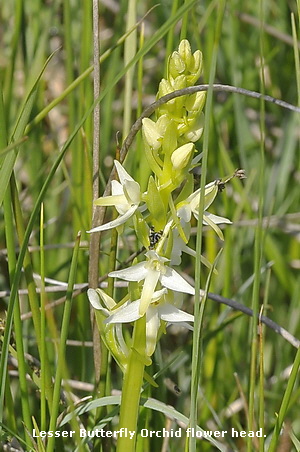
Two species of Butterfly Orchid.
A more detailed view of the complex flowers of this species. The Lesser Butterfly Orchid is similar to another species not yet found around Lough Allen, the Greater Butterfly Orchid, but its flowers are not quite as big.
(The structure and anatomy of the flowers is shown in two more photographs below.)
|
|
|
|
|
|
|
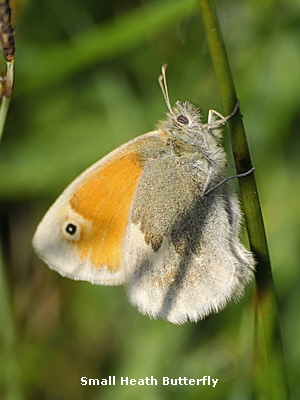 Small Heath. Small Heath.
Glad to see this Butterfly at this site, and they were abundant on the hot sunny day on which this photograph was taken.
This species is often regarded as a coastal species but Lough Allen is, of course, well inland. Perhaps either the richness of flowering plants and the pleasant south easterly aspect (very open to the Summer sunshine) appealed to these butterflies. They were also seen feeding on the Lesser Butterfly Orchids which seem unusually abundant in these meadows.
|
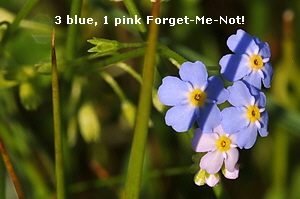 Forget-me-Not. Forget-me-Not.
Always nice to see the bright cheerful flowers of the Forget-me-not! This one is included because of it’s cutely different pink flower!
.
|
|
 Marsh Fritillary Marsh Fritillary
We were very pleased also to find this Marsh Fritillary here. One of our favourite butterflies, not widespread, and it is good to see it occurring frequently in the north west. The Marsh Fritillary has very specialised plant and habitat requirements if it is to successfully breed, as it is doing in the Lough Allen area.
This is a species that is in severe decline around Europe and conservation action is required for this species by the EU. This is yet another reason why we believe Lough Allen should be regarded as a very special place and the base for a regional conservation initiative

|
|
|
|
|
|
|
|
|
The common structure of Orchids.
What is an Orchid? There seems to be a lot of variety in shape and size; what are the common factors that define an orchid as an Orchid?
This photograph fairly clearly shows the anatomy of an Orchid flower. The ring of 3 sepals is showing up whitish here with the 3 petals arranged in front of and below the sepals.
Note the twisted flower stem and the very long backwardly extended spur that is characteristic of this species.
|
|
|
|
|
 Identification. Identification.
This photograph shows the 2 pointed lateral sepals and the third sepal forming a hood over the top of the flower along with two petals. The labellum is long and thin and pointing straight downwards in this photograph.
An identifying feature of this plant is the two shortish and parallel pollinia which can be seen in this photograph. (They are greenish and hanging down over the top of the labellum.) These are pollen sacks arranged to contact the head of any visiting insect and thus transfer the pollen to another plant. The pollinia are curved in the closely related species, the Greater Butterfly Orchid.
|
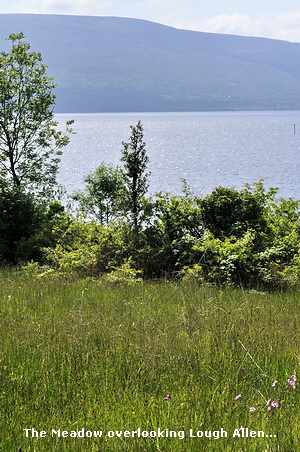 This flower rich meadow has several wet flushes and drains directly to Lough Allen into which it rapidly slopes. These flushes and the probable basic nature of the ground and water may favour the occurrence of the Lesser Butterfly Orchid which was found in abundance here in the early days of June this year... This flower rich meadow has several wet flushes and drains directly to Lough Allen into which it rapidly slopes. These flushes and the probable basic nature of the ground and water may favour the occurrence of the Lesser Butterfly Orchid which was found in abundance here in the early days of June this year...
Climate and Biodiversity.
2010 has also been a very dry year and at present, warm and suitable for Orchids to thrive and flower. The shore line shown opposite is one of the areas where the rarer Orchid, Spiranthes romanzoffiana (Irish Lady’s Tresses) has been found in recent years. This species is totally dependent on a constant and a low water level around Lough Allen during it’s flowering and seeding season (July to October)... something that has become less common with increasing Summer rain fall in the area.
|
|
|
|
|
|
|
Early Marsh Orchid
Another favourite Orchid, the Early Marsh Orchid also occured in this small area of pasture.
It is a very upstanding Orchid with a large densely packed flowering heads. The colour is variable but typically quite reddish. (This specimen actually seemed redder than reproduced and there may be some technical problems to do with colour balance on this photograph.)
The Red Flowers may indicate a presence of lime rich ground water.
|
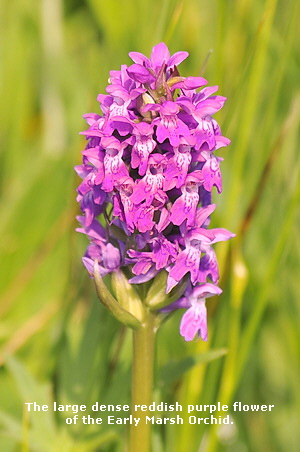
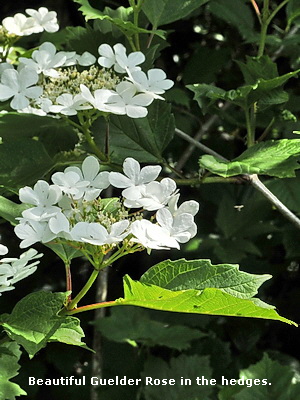 Guelder Rose Guelder Rose
A charming bright hedgerow species with luscious large green leaves and the purest white flowers. Widespread and common in Leitrim but always a great pleasure to see and to photograph.
|
|
|
|
|
|
|
|
 Common Spotted Orchid. Common Spotted Orchid.
A very common Orchid to be found throughout fields and along roadsides in the early Summer. But still a very beautiful flower especially when examined close up. It can be identified by its labellum which is divided nito three with the central lobe typically longer and more pointed.
Colour of the flower can vary a lot from almost white to lilac to deep pink.
Six Spot Burnet.
A day flying and abundant Moth found throughout Ireland. However it is a colourful species and always very active on warm days and in suitable places
The caterpillar food plant is Bird’s Foot Trefoil which was common in the area.
|
Autumn at the Meadow! |
A Sawfly discovered on this meadow this Autumn. Photographed & reported by Fíona Farrell, (NPWS). Many thanks to her for this contribution!
|
|
Scabious Sawfly
On the 7th of October 2010, I encountered this Sawfly busily feeding on Devilsbit Scabious flowers in Drummans Lower near the shores of Lough Allen. I was out looking for Marsh Fritillary webs, as an adult Butterfly had been seen flying around this field in the Summer. I didn’t find any Marsh Fritillary webs but finding this species was a welcome substitute. What is initially striking about these larvae is that their grey, black and yellow colouration superficially resembles the colour of the pupae of Marsh Fritillaries. Like the Butterfly it also feeds on Devilsbit Scabious.
It was voraciously eating the flower head of Devilsbit Scabious when I found it, and curled round into a tight ball when disturbed. With a focus now on monitoring Marsh Fritillary butterflies (as an Annex II species) more and more people are out and about at this time of year looking for Fritillary webs in suitable Devilsbit Scabious habitat. A consequence of this is that more records of this sawfly species are turning up, seeming to indicate that this species may be more common in Ireland than previously thought.
|
|
|
The larvae of this species is quite similar to Abia candens which it can sometimes be associated with as they share similar food plants (Devilsbit and Field Scabious). Abia candens is rare; it has similar markings to A. sericea except the black markings on the back are absent in A. candens and the side markings are tear dropped shaped instead of heart shaped.
The adults are reputed to be spectacular metallic green insects with fat bodies and shading on the wings, which can be found buzzing around food plants. I look forward to seeking them out in the Summer!
|
|
|
NOTES
Abia sericea belongs to the Order Hymenoptera, sub-order Symphyta – The sawflies. These insects are separated from the rest of the Hymenoptera by the absence of a waist. Most sawfly larvae are superficially like caterpillars and can be mistaken for such at first. Sawfly larvae can be distinguished from the larvae of moths and butterflies in that they have at least 6 pairs of abdominal legs or prolegs, wheras true caterpillars never have more than 5 pairs of prolegs.
The common name for this group of insects refers to the ovipositor which looks like a minute saw. This is used to cut slits into stems and leaves, into which eggs are then laid.
There are 12 families of sawflies within the sub-order, the most numerous being the Tenthredinidae family which comprises about 900 European species, some 400 of which occur in the British Isles. Abia sericea belongs to a much smaller family of sawflies, the Cimbicidae. There are about 10 species of this family in Ireland.
Abia sericea is one of several species being considered as a biological control agent in the USA for the non-native Teasel which is becoming a pest species there. Teasels belong to the same flower family as Field and Devilsbit Scabious and tests have shown that Abia sericea will feed on Teasel flowers also.
|

|
|
 [All the photographs of larvae are from Fíona. The photograph of the adult (included for the sake of completeness) is taken from the brilliant Insect site, GALERIE DU MONDE DES INSECTES, with grateful acknowledgement to them for that wonderful resource. They provide both an excellent facility for identifying Insects and a very generous policy of help to education and conservation bodies such as ourselves. Much appreciated!] [All the photographs of larvae are from Fíona. The photograph of the adult (included for the sake of completeness) is taken from the brilliant Insect site, GALERIE DU MONDE DES INSECTES, with grateful acknowledgement to them for that wonderful resource. They provide both an excellent facility for identifying Insects and a very generous policy of help to education and conservation bodies such as ourselves. Much appreciated!]
(LAB 2/2/’11)
|
© GALERIE DU MONDE DES INSECTES
|
UPDATE 2011: Second Species found!
Another SPECIES of SAWFLY found at Lough Allen!
Guess what? Same place, same field, while we were searching for Marsh Fritillary caterpillars, a further group of Sawfly larvae were again turned up by us with the assistance of Fíona Wheeldon (neé Farrell). Only 3 specimens were found and this time they were all of another species, Abia candens.
|
Abia candens and Abia sericea are very similar and frequently occur together. They are not very rare but tend to be overlooked. The main concern is that they may often be thought of as Caterpillars of Butterflies and are in fact a totally separate group of animals. The larvae of Sawflies have 6 or more pairs of prolegs, fleshy non-articulated legs at the rear of the body, whereas Caterpillars have 5 or less.
The two specimens of A. candens below can be told apart from their cousins (all other photos on this page) by the absence of black dots along the top centre of their bodies and the fact that the black markings on the side are tear shaped rather than heart shaped. Compare the images below with those above.
|
|

Abia candens
Found on Devil’s-bit Scabious
at Drummans, Lough Allen.
(26th September 2011)
|

Photos by...
Fíona A. Wheeldon
|
|
BACK (to Index for this Section.) NEXT Topic (GULLS) Lough Allen Basin HOME
|